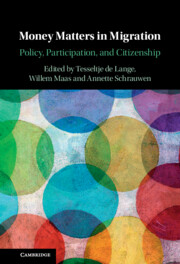Book contents
- Money Matters in Migration
- Money Matters in Migration
- Copyright page
- Contents
- Notes on Contributors
- 1 Money Matters in Migration: A Synthetic Approach
- Part I Migration
- Part II Participation
- 9 “This Is Affordable!” The Role of Money Matters in the Use of Live-In Migrant Care Arrangements
- 10 De-magnetizing the Market: European Integration, Employer Sanctions, and the Crackdown on Undeclared Work
- 11 Women as EU Citizens: Caught between Work, (Sufficient) Resources, and the Market
- 12 Migrant Financial Inclusion versus the Fight against Money Laundering and Terrorist Financing
- 13 Migrant Remittances and Money Laundering in Africa
- Part III Citizenship
- Index
- References
10 - De-magnetizing the Market: European Integration, Employer Sanctions, and the Crackdown on Undeclared Work
from Part II - Participation
Published online by Cambridge University Press: 12 November 2021
- Money Matters in Migration
- Money Matters in Migration
- Copyright page
- Contents
- Notes on Contributors
- 1 Money Matters in Migration: A Synthetic Approach
- Part I Migration
- Part II Participation
- 9 “This Is Affordable!” The Role of Money Matters in the Use of Live-In Migrant Care Arrangements
- 10 De-magnetizing the Market: European Integration, Employer Sanctions, and the Crackdown on Undeclared Work
- 11 Women as EU Citizens: Caught between Work, (Sufficient) Resources, and the Market
- 12 Migrant Financial Inclusion versus the Fight against Money Laundering and Terrorist Financing
- 13 Migrant Remittances and Money Laundering in Africa
- Part III Citizenship
- Index
- References
Summary
Economic incentives shape migratory decisions and therefore play an important role in immigration enforcement. Facing limits on the utility of formal border controls or forced removals as ways of combating irregular migration, governments in Europe have sought to ‘de-magnetize’ their economies – rendering life in their countries infeasible or unattractive by making it difficult for irregular migrants to find paid work. Although governments initially focused on penalizing employers who hire migrants lacking legal authorization to work, in recent decades they adopted a wider set of initiatives targeting undeclared work of all kinds. This chapter explores these initiatives, tracing their emergence in a number of Northern European countries and subsequent diffusion across Europe. One theme of the chapter concerns the effect of these measures on the relationship of states to economies. Another theme concerns the impact of these initiatives on irregular migrants who, if they remain within these countries, can be pushed into the shadowy depths of advanced industrialized economies.
- Type
- Chapter
- Information
- Money Matters in MigrationPolicy, Participation, and Citizenship, pp. 169 - 187Publisher: Cambridge University PressPrint publication year: 2021



